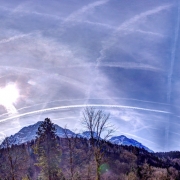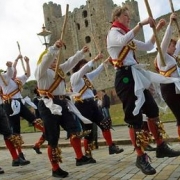Back to the Land: The Path to Self-Sufficiency
By Asbrandir AOR
First published ORB 208, Spring 2259
In writing this article, it is my aim to start an on-going discussion on the idea of living in a community attempting to live as self-sufficiently as possible. I shall say now that I myself have just begun learning about this path and I can only do my best to explain my thoughts and ideas here. This is an open discussion, where ideas, positive energy and of course constructive criticism are readily accepted.
The ultimate aim would be to get a handful of Odinists together who have learned the skills and knowledge needed to work the land and successfully reap its bounty, so that said Odinists might purchase land and work it together. They would live with their families in separate cabins/houses, but all work together in the day on various projects, from growing vegetables to mending fences to milking goats. This perhaps sounds highly improbable and very difficult to co-ordinate, and yes it would be, but that does not make it impossible.
Whilst I was in Norway during the summer, I visited the only organic farming school in the country, as the people I was staying with were friends with the horse-work trainer there. This school offers a two-year course in organic farming methods, and in Norway tuition is free so long as you pass at the end. All you need to pay for is the accommodation and food costs (here that totals at approximately £300 per month). You would need to be able to speak and understand Norwegian, but this is a language that can be quite quickly picked up by English speakers, even more so if they know a little German. The path I took was first to purchase Margaretha Dan bolt Simmons’ ‘Teach Yourself Norwegian’ CD and book set, available from Amazon – it is a very effective guide, and I strongly recommend it. After completing half of this book, I had enough Norwegian to find a job on Norway’s premier job search site. I have been working as a stable-worker in Tidemark, and I’m speaking Norwegian everyday. It had been my hope that by August, I would have had enough Norwegian and money saved up to start the two-year organic farming course previously mentioned. During those two years, I had hoped to make contacts in the world of organics and learn all I can whilst I’m there. After the two years, it had been my plan to begin working to save up for some land (plus have enough saved in the bank for unforeseeable costs), perhaps to be bought in 10-15 years time. The reason I speak of these things in the past tense is because I have, temporarily at least, put these plans on hold, as I shall be returning to England soon for a number of reasons, being with my OR comrades and joining a Hearth being the principal one.
Anyway, this is just a skeletal plan, and although basic, it is as detailed as it could sensibly be made for the moment. What’s more, it is a plan that anyone can use and adapt to their own situation and skills. So if it were possible to gather had a handful of Odinists together studied at this school (or at other locations, for example Killeen smallholding school run by the wife of the late great John Seymour in Ireland), I think the aim of a self-sufficient community becomes much closer to being achieved. I believe that with an iron will and great drive, it would be possible to teach oneself the necessary of skills and learn the required knowledge of the land by reading and experiencing it alone, although the path would perhaps be rather longer and more difficult.
I realise of course that it is simply not possible for everyone on Earth to become self-sufficient, for there seems barely enough land to house the spiralling populations, let alone enough for them to have land to grow all they eat. But I’m not talking about the global population, I’m talking about Odinists, we who care about the welfare of the Earth and who wish to exist in harmony with it, living with it like guardians, not off it like parasites. The rest can fall by the wayside in their disregard and disrespect for the Earth.
I’ll now present you with an example of a family who are attempting to live this very life. The family with whom I stayed with in Norway during the summer bought their 98 acres, plus the few dilapidated buildings on it, in Telemark some six years ago for around 400 000 NOK (approx. £40 000). Although they are not self-sufficient, their Jersey cow and three goats provide 9 and 3 litres of milk respectively – enough for making plenty of soft-cheese, the best butter I’ve ever tasted, the occasional hard cheese, and of course more than enough to drink. They make tyttebaer (not sure of the English name), blackcurrant and raspberry jam from the berries they gather on the hillsides nearby, and they also fish the river. Ole also brews some beer from time to time. Although much of their land is un-farmable forest and is situated on a hillside, they have managed to successfully grow vegetables in the kitchen garden and many kilos of potatoes on the slope. They use a large wood-burning stove for heat and cooking, the fuel for which is growing on the hill all around them. These people choose to live without electricity – not a decision I would personally make, as I severely missed a hot shower in the cold mornings and access to the internet. I do not know a lot about renewable energy solutions, but I believe it would be possible to acquire solar panels/tubes for heating water and powering a computer and a few lights – so there is no need to live by candle light through the winter! Like most things, this is an issue that can easily be investigated and resolved with a little time and effort.
However, another obstacle is the number of members in a family that live immediately together today. In times gone by, when families were much larger, and when large-scale tasks such as haymaking came around, the extended family and the neighbours would have all pitched in to make this arduous duty a success. On the mountain farm in Norway described above, they are very dependent on volunteers to help them run the place, for there is so much to do, and there is only so much two-pairs of hands can do, no matter how long and hard they work. This means there is much to be said for living in a small community of folk attempting to live self-sufficiently together. Not only will this make large-scale tasks possible, each member would hopefully bring different skills and knowledge, which could be pooled. This would mean, at least for certain things, no money need change hands. For example, if there was a fault with a vehicle and a mechanic was counted among the group, he could fix said vehicle and the owner, if he/she was skilled at making clothes/baskets etc, could give him a few items in return for the favour.
So although it would seem that total self-sufficiency is perhaps now unattainable in our modern world, there is much that can be done short of it. Of course we’ll always need money for buying things we couldn’t make ourselves, but there are solutions for that as well. Let us take the example that you may be producing too much milk/cheese/vegetables/eggs/firewood for your own consumption. I believe the vegetables, eggs and firewood could be sold without much hassle from the state, however there would be a problem with the dairy. You couldn’t sell the milk/cheese to the general public without using sanitised, highly regulated (expensive) dairy facilities, but I believe there is nothing stopping you from putting up a sign on the road offering ‘Free Cheese – donations most welcome’. People are unlikely to take your produce without contributing something – perhaps giving more than you would have sold it for! I don’t know all the inns and outs of selling home-produced food, and this seems pretty fair to me, but perhaps there is a law I have overlooked.
In terms of outside employment, my Englishman friend in Norway is a lorry driver here, and says it is possible to work well-paid, very flexible shifts, so that once you have saved up and bought your land, you could perhaps just work weekends to cover the overheads, and spend the rest of the week working the land and being with your family. He says he has enough saved up already but is unsure where he’d like to settle, plus he has to take into account his girlfriend’s wishes. Still, I think it is very exciting for him, and a great inspiration, as he is only 28 and therefore has many years ahead to make a whole-hearted attempt. And I reckon he’ll do it.
I understand and appreciate that for many of us it is simply not possible to change the course of our lives so drastically, for a plethora of reasons. But for those who have children, or know young members of our Folk who are seeking for something but are unsure what exactly, perhaps this would be one of the directions in which we could point them.
For those living in the UK, I can recommend one specific WWOOF (Willing Workers On Organic Farms) farm in Scotland that is an excellent example of two good people trying to work towards self-sufficiency. They are honest, straight-talking, hard-working folk and I hope to visit them again when I have the chance. For more info on WWOOF, see www.wwoof.org.
In conclusion, if this article only serves to fire a few imaginations and get folk thinking then it has been successful. There are many difficulties on a path like this, not least of all getting several folks together that are able to make such a commitment and get on well enough to work together everyday. It isn’t something that can happen overnight, it needs many years of investment, in time, energy and unfortunately, money. But for those who see cannot imagine themselves striving for, and eventually living such a life, those factors are just obstacles to be overcome, and eventually will be.
I would be interested in your comments.
Recommended reading:
John Seymour’s ‘The New Complete Guide to Self-Sufficiency’- this is the comprehensive guide, highly recommended as an introduction. Available from Amazon.
www.selfsufficientish.com – a fantastic amateur website full of useful, practical and entertaining advice on becoming ‘self-sufficient-ish’
1. http://www.sjh.vgs.no/
2. http://www.self-sufficiency.net/
3. The basic idea of WWOOF is that you work on an organic farm and receive board and lodgings, along with (hopefully) some useful experience and contacts. No money changes hands, all you pay for is travel costs, so it can be a very good (not to mention thrifty!) way of getting to see another country and meet folk there. I decided to try this activity out first in Scotland, where the language barrier should hopefully be minimal, and then, if all went well, to attempt it in Norway



I think it’s a wonderful idea, one that I would definitely love to be a part of in the future if at all possible! 🙂